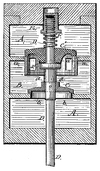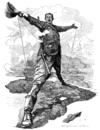Portal:Trains/Did you know/May 2009
Appearance
May 2009
[edit]- ...that New Zealand's North Island Main Trunk Railway connects Auckland and Wellington via the Raurimu Spiral, a single-track railway spiral and horseshoe curve described as an engineering masterpiece, which overcomes a 132 m (433 ft) height difference with a ruling gradient of just 1 in 52?

- ...that the Eastern Railway section between Perth and Northam, Western Australia, which forms part of the main Sydney to Perth transcontinental railway, has had three entirely separate route alignments during its 125 year history?
- ...that the American EMD DD35 locomotive, a 5,000 hp (3.7 MW) eight-axle B unit, was essentially two GP35s built on one frame in response to a Union Pacific request for a 15,000 hp (11 MW), three-unit set to replace their fleet of turbines?
- ...that the route length of Belgium's Vicinal tramways, a network of narrow gauge tramways or local railways, exceeded that of the country's mainline railway system?
- ...that the New Zealand Railways K class 2-4-2 steam locomotives of 1877, a highly successful design that had profound influence on New Zealand locomotive development, were dumped in the Oreti River for embankment protection after retirement in the 1920s and one, K 88, has been recovered from the riverbed and restored to full working order?
- ...that the EMD DDM45, a narrow gauge version of the SD45 built for service in Brazil, required two additional driving axles since the smaller narrow gauge traction motors would otherwise be overloaded by the locomotive's electrical output?
- ...that the Juice Train, the popular name for famous train of Tropicana fresh orange juice operated by railroads in the eastern United States, was the first unit train in the food industry?
- ...that slack action, the amount of free movement of one railway car before it transmits its motion to an adjoining coupled car, can aid in starting heavy trains, since the application of the locomotive power to the train operates on each car in the train successively, and the power is thus utilized to start only one car at a time?
- ...that while Great Northern Rail Services spearheaded rail privatisation in Victoria, Australia, in November 1994 with the first privately owned and operated locomotives on the Public Transport Corporation network, by November 2002 the company had ceased operations due to the increased public liability insurance costs?
- ...that Bombardier Transportation's TRAXX locomotive's name is an acronym for Transnational Railway Applications with eXtreme fleXibility; reflecting the versatility of a locomotive design with both passenger and freight applications and both electric and diesel variants, later electric versions of which are quad voltage machines able to operate on most European electrification schemes?
- ...that China's Beijing–Tianjin Intercity Rail, which opened on August 1, 2008, enabled the 120 km (74.565 mi) journey between Beijing and Tianjin, a city co-hosting football matches at the 2008 Beijing Olympics, to be shortened from the original 70 minutes to 30 minutes?
- ...that the Georgia Railroad and Banking Company, a U.S. rail operator which was originally chartered in 1833, has long since had its rail operations subsumed by CSX Transportation, but continues to operate in the real estate development business, controlling numerous properties along its former rail lines?
- ...that the only ways to reach the shrine and ski resort at Vall de Núria in the Catalan province of Girona, in Spain are by a footpath or the Vall de Núria Rack Railway?
- ...that the Furka Pass section of Switzerland's Furka-Oberalp-Bahn, which used to close each winter and was subsequently replaced by new route using a 15.381 km (9.557 mi) tunnel, is now operated by the company Dampfbahn Furka-Bergstrecke and run as a heritage railway with steam locomotives?
- ...that new China Railways QJ class 2-10-2 steam locomotives were being produced as recently as 1988, and they include modern features such as air horns, toilet and cooking facilities?
- ...that the now discontinued Microsoft Train Simulator software allowed users to create their own routes, and third party modifications were available either as freeware or payware to add other locomotives and rolling stock?
- ...that the Nederlandse Spoorwegen (Dutch Railways) Class 1500 electric locomotives were originally built for the United Kingdom's only 1500 VDC line (the Woodhead Route) and following the closure of that line at the time of a shortage of locomotives on the Nederlandse Spoorwegen, the entire class was sold to the Netherlands?
- ...that Bucharest's Gara de Nord railway station was heavily bombed by the Allies in 1944 in a campaign aimed at the German supply lines, as the station played an important part in the Romanian railway network and was the main departure point for troops headed to the Eastern Front?
- ...that of the 1340 Class 141R 2-8-2 steam locomotives built for the SNCF (French National Railways) by American maunfacturers in the immediate postwar period, only 1323 actually entered service as 16 were lost at sea off Newfoundland when the ship transporting them sank in a violent storm, and a seventeenth was lost in the Marseilles harbour while unloading?
- ...that the Strasburg Rail Road, an American heritage railway running tourist train services, has among its fleet of steam locomotives a former Brooklyn Eastern District Terminal engine rebuilt to resemble Thomas the Tank Engine, a modification the Strasburg's VP and Marketing Officer said "makes steam exciting for the next generation"?
- ...that the Western Australian Government Railways' X class diesel electric locomotives of 1954 shared the same highly unreliable Crossley HST-Vee8 prime mover as the Irish CIE 001 Class and British Rail Class 28 locomotives, however rather than re-engine or scrap the fleet as the CIE and BR did, the WAGR managed to rectify hundreds of defects in the Crossley design and eventually obtain reliable performance?
- ...that the Highland Railway of Scotland's Jones Goods class leader No. 103 was the first 4-6-0 locomotive in Britain and at the time its most powerful locomotive, and after being set aside for preservation by LMS in 1934 and restored to running order in 1959 by British Railways, it starred in the 1965 movie Those Magnificent Men in their Flying Machines?
- ...that despite the success of Russia's first steam locomotive, built in 1834 by engineers Yefim Alekseyevich Cherepanov and Miron Yefimovich Cherepanov, their invention found no support and was replaced by horse traction?
- ...that Austrian engineer Hugo Lentz won the grand prize at the Exposition Universelle (1900) in Paris and is best known for his steam valve gear with oscillating and rotating cams to actuate poppet valves?
- ...that compensation to landowners whose properties were in the path of Ireland's first railway, the Dublin and Kingstown Railway, included for Lord Cloncurry the building of a private foot bridge over the line to a bathing area complete with a Romanesque temple, a short tunnel and a cutting to maintain his privacy?
- ... that although the Union Pacific Big Boy is often billed as being the largest steam locomotive ever built, in each of the categories of weight, length, horsepower and tractive effort a larger locomotive can be found?
- ...that the Mullard Radio Astronomy Observatory uses a section of the now-abandoned Cambridge-Bedford railway line, running nearly East-West for several miles, to form the main part of the "5km" aperture synthesis radio telescope and the Cambridge Low Frequency Synthesis Telescope?
- ...that obstacles to the completion of the Cape to Cairo Railway, a project to cross Africa by rail first proposed in the late 19th century, have included opposition to British colonial expansion by other colonial powers, the use of three different rail gauges on completed sections, through to the current ongoing turmoil in Sudan?
- ... that the Listowel and Ballybunion Railway (a Lartigue Monorail that operated in Ireland between 1888 and 1924) required each side of the carriage to be equally balanced and thus if a farmer wanted to send a cow to market, he would have to send two calves to balance it, with the calves then having to travel back on opposite sides of the same freight wagon, balancing each other?
- ...that the American H-8 "Allegheny" class of the Chesapeake and Ohio Railway and Class AG on the Virginian Railway, the only classes of 2-6-6-6 locomotives, are believed to be the heaviest and possibly the most powerful steam locomotives ever built?


























